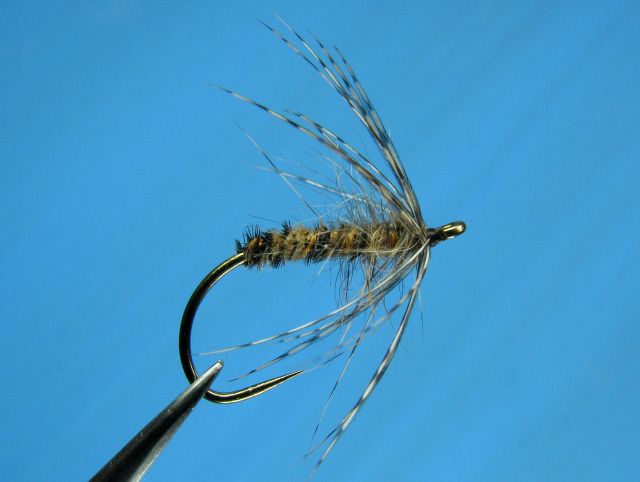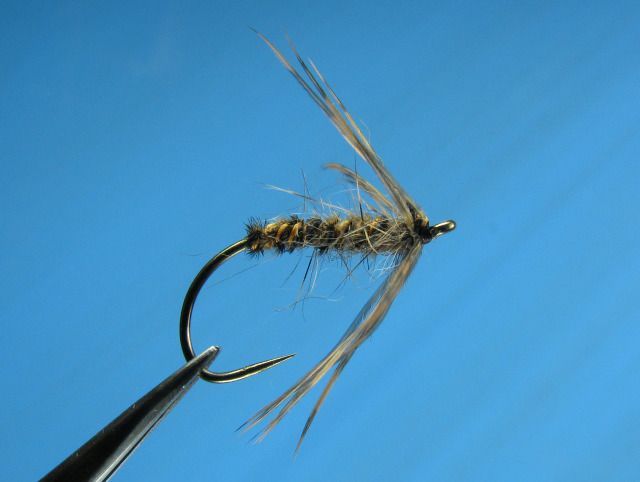Page 1 of 2
Golden Pheasant Dubbed Twists 1250's
Posted: Tue Jul 10, 2012 11:44 am
by William Anderson
Back to the twists. For these I tied in the silk to be twisted with the herl at mid shank and let the portion toward the eye hang down long then bound the silk and herls toward the bend. After twisting the herl and silk together I brought them back up the shank and after 3-4 turns of the herl twist I dropped the other silk portion to be dubbed and continued the herl twist to the thorax. Then I waxed and lightly dubbed the dropped silk to be brought forward and cover the front 2/3 of the body. It's not a big difference between adding a thorax but it put a bit of a shroud over the herl and makes a nice transition to the hackle.
Golden Pheasant Twist Dubbed and Partridge 1250
 Golden Pheasant Twist Dubbed and Woodcock 1250
Golden Pheasant Twist Dubbed and Woodcock 1250

Hook: Daiichi 1250
Tying Thread: Griffiths 14/0
Hackle: Partridge - Woodcock
Herl Twist: Golden Pheasant Tail twisted with Pearsall Orange Gossamers Silk
Shroud: Pearsall Orange Gossamer Silk dubbed with Hare and Australian Opposum blend
w
Re: Golden Pheasant Dubbed Twists 1250's
Posted: Tue Jul 10, 2012 3:39 pm
by Mataura mayfly
William,
This is using GP hen or Cock? Looks like fibres from the male bird. I use it in similar ways..... but wrapped around the shank untwisted. If you pick the hook shank and the fibres just right you can get a really neat segmented abdomen. Not there is anything wrong with your offerings, great looking flies and combination of materials.
Re: Golden Pheasant Dubbed Twists 1250's
Posted: Tue Jul 10, 2012 6:44 pm
by William Anderson
Jeff, thanks. This is a cock tail. Apparently there are Flame Golden Pheasants and Red Golden Pheasants. I have more of the Flame Golden tail feathers then the Red, but this is the Red Golden. They both have wonderful tones and mottling.
http://www.aviangenetics.com/Flame_Gold ... tures.html
w
Re: Golden Pheasant Dubbed Twists 1250's
Posted: Wed Jul 11, 2012 2:03 pm
by tie2fish
Both of these are quite innovative, but that 1st one (with the partridge) is pretty close to aesthetic perfection in my eye.
Re: Golden Pheasant Dubbed Twists 1250's
Posted: Thu Jul 12, 2012 5:04 am
by Ruard
William Anderson wrote:Back to the twists. For these I tied in the silk to be twisted with the herl at mid shank and let the portion toward the eye hang down long then bound the silk and herls toward the bend. After twisting the herl and silk together I brought them back up the shank and after 3-4 turns of the herl twist I dropped the other silk portion to be dubbed and continued the herl twist to the thorax. Then I waxed and lightly dubbed the dropped silk to be brought forward and cover the front 2/3 of the body. It's not a big difference between adding a thorax but it put a bit of a shroud over the herl and makes a nice transition to the hackle.
w
Hi William, a video of these twisting and let hang and dubbing the thorax would be very helpful for a simple mind like me.

Greeting
Re: Golden Pheasant Dubbed Twists 1250's
Posted: Thu Jul 12, 2012 8:58 am
by Old Hat
They look wonderful, but I'm with Ruard, having a difficult time following what you did.
By the way this is a great fish catcher. Syl Nemes calls it the Golden pheasant tail with fur thorax and lists it as number 16 in his top 20.
Body: 2/3 golden pheasant tail and copper wire
Thorax: light hare's face
Hackle: medium partridge
I do like the addition of the silk thread showing through and great way to subtly be able to adjust the hue of the pattern.
Re: Golden Pheasant Dubbed Twists 1250's
Posted: Thu Jul 12, 2012 9:03 am
by Old Hat
OK I read it a couple more times. I think I got it. Sorry.
Re: Golden Pheasant Dubbed Twists 1250's
Posted: Thu Jul 12, 2012 10:39 am
by William Anderson
Thanks. Sorry for the clumbsy description. It's such a such a simple, nothing of a technique that it hardly warrents an explaination, certainly shouldn't require a SBS and will not likely appear on youtube any time soon...so how is it that I can bugger up explaining such a small step? I'm expressing thoughts in "word salad" form like a pro more now than ever. It's a well practiced skill.


It's the same idea as allowing a rib to remain off the bend, to be brought forward after the body is wrapped, execept the material is hung perpindicular to the shank at the 1/3 body length position with 2/3's remaining to the thorax so that the dubbed portion covers 2/3 of the body once it's brought forward. Yes a diagram would be easier.
I love this pattern and every conceivable combination of these materials works for me. I didn't realize Nemes described this exact pattern, but it's not suprising, he had a good sense about these things.

I like the Ringneck Pheasant tails as well, of course, but I was looking though all my boxes and pics, etc and by a large percentage I use more grouse tail and Golden Pheasant, along with mottled turkey tail, usually cinnamon - than Ringneck Pheasant. The length and scale of the Golden Pheasant fibers is actually a little longer, but not bulkier than Ringneck and the mottling is gorgeous. I like the look of the material, not unlike the strange attraction of a beautiful cape, partly for their potential and partly...just because they are beautiful. yada yada.
I'll try to do an sbs if you're interested.
Re: Golden Pheasant Dubbed Twists 1250's
Posted: Thu Jul 12, 2012 11:29 am
by Old Hat
William Anderson wrote:. I didn't realize Nemes described this exact pattern, but it's not suprising, he had a good sense about these things.

.
It appears you both have a good sense about these things.
Your description was fine it was my understanding that was skewed.

sometimes the simple code is the hardest to crack.
Re: Golden Pheasant Dubbed Twists 1250's
Posted: Thu Jul 12, 2012 6:43 pm
by CreationBear
I love this pattern and every conceivable combination of these materials works for me.
Definitely one of those "24/7" patterns for all but the most neurasthenic trout wth just the GP, but there are so many nicely colored feathers out there now--e.g. dyed mallard, Amherst center tails, etc--that you ought to be able to fine-tune the shading just by adding a different mix of feather fibers.
FWIW, anybody else think that the GP-bodied flymph will outfish a quill-body fly 3-to-1?




